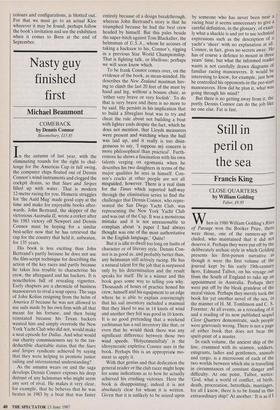Nasty guy finished first
Michael Beaumont
COMEBACK by Dennis Connor Bloomsbury, £13.85 In the autumn of last year, with the eliminating rounds for the right to chal- lenge for the Americas Cup in full swing, the computer chips floated out of Dennis Connor's wind instruments and clogged the cockpit drains, so that Stars and Stripes filled up with water. That is modern 12-metre racing for you. Homeric struggles for 'the Auld Mug' made good copy at the time and make for enjoyable books after- wards. John Bertrand, the skipper of the victorious Australia II, wrote a corker after his 1983 victory off Newport and Dennis Connor must be hoping for a similar best-seller now that he has retrieved the cup for the country that held it, unbeaten, for 135 years.
His book is less exciting than John Bertrand's partly because he does not use the film-script technique for describing the action of the key races and partly because he takes less trouble to characterise his crew, the afterguard and his backers. It is nonetheless full of revealing vignettes. Early chapters are a chronicle of business manoeuvres to rival a soap opera. The saga of John Kolius resigning from the helm of America II because he was not allowed to use sails made by his own firm with all that meant for his fortune, and then being reinstated because his Texan backers wanted him and simply overrode the New York Yacht Club who did not, would make a neat episode for Dallas. And what would our charity commissioners say to the tax- deductible charitable status that the Stars and Stripes syndicate achieved by saying that they were helping to promote junior sailing and international understanding?
As the autumn wears on and the saga develops Dennis Connor exposes his deep distrust of any helmsman who might seem any sort of rival. He makes it very clear, for example, that he believes that he was beaten in 1983 by a boat that was faster entirely because of a design breakthrough, whereas John Bertrand's story is that he triumphed because he had the best crew headed by himself. But this pales beside the super-bitch against Tom Blackaller, the helmsman of U.S.A., whom he accuses of taking a hacksaw to his, Connor's, rigging in a previous Star World Championship. That is fighting talk, or libellous; perhaps we will soon know which.
To be frank Connor comes over, on the evidence of the book, as mean-minded. He describes the New Zealand mastman hav- ing to climb the last 20 feet of the mast by hand and leg, without a bosuns chair, as 'either very brave or very foolish'. To do that is very brave and there is no more to be said. He persists in his implication that to build a fibreglass boat was to try and cheat the rule about not building a boat with lighter ends despite the fact, which he does not mention, that Lloyds measurers were present and watching when the hull was laid up, and it really is too disin- genuous to say, 'I suppose rriS, concern is more philosophical than practical'. Furth- ermore he shows a fascination with his own talents verging on egomania when he describes his two daughters in terms of the major qualities he sees in himself. Con- nor's cracks at other people are not all misguided, however. There is a real slam for the Times which reported half-way through the elimination series to find the challenger that Dennis Connor, who repre- sented the San Diego Yacht Club, was representing the New York Yacht Club and was out of the Cup. It was a monstrous mistake and it is not unreasonable to complain about 'a paper I had always thought was one of the most authoritative in the English language.' Quite!
But it is idle to dwell too long on faults of character or of literary style. Dennis Con- nor is as good as, and probably better than, any helmsman still actively racing. He has a natural talent for the job that is surpassed only by his determination and the result speaks for itself. He is a winner and this book goes some way to telling you why. Thousands of hours of practice honed his crew, himself and his equipment to an edge where he is able to explain convincingly that his sail inventory included a mainsail that they liked to use in 14 knots of wind and another they felt was good in 16 knots. It is no good pretending that a weekend yachtsman has a sail inventory like that, or even that he would think there was any significant difference between those two wind speeds. `HolycrimeinItaly' is the idiosyncratic expletive Connor uses in the book. Perhaps this is an appropriate mo- ment to apply it.
With that genius and that dedication the general reader or the club racer might hope for some indications as to how he actually achieved his crushing victories. Here the book is disappointing; indeed it is not absolutely clear for whom it is written. Given that it is unlikely to be seized upon
by someone who has never been near a racing boat it seems unnecessary to give a careful definition, in the glossary, of exact- ly what a shackle is and yet to use technical expressions such as the description of a yacht's 'sheer' with no explanation at all. Connor, in fact, gives no secrets away. He has of course a defence to mount in three years' time, but what the informed reader wants is not carefully drawn diagrams of familiar racing manoeuvres. It would be interesting to know, for example, just how he controlled his opponents in the pre-start manoeuvres. How did he plan it, what was going through his mind?
But there is no getting away from it, the portly Dennis Connor can do the job like no one else. Fat is fast.



























































 Previous page
Previous page